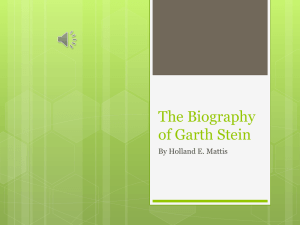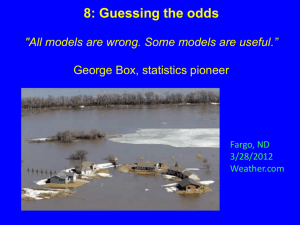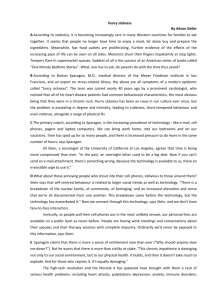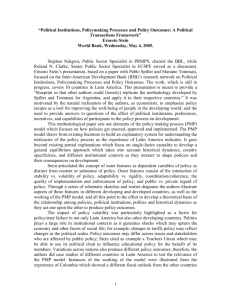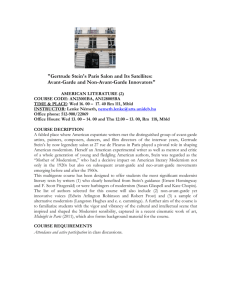THE UNION PROBLEM ON COMPLEX MANIFOLDS PATRICK W. DARKO
advertisement
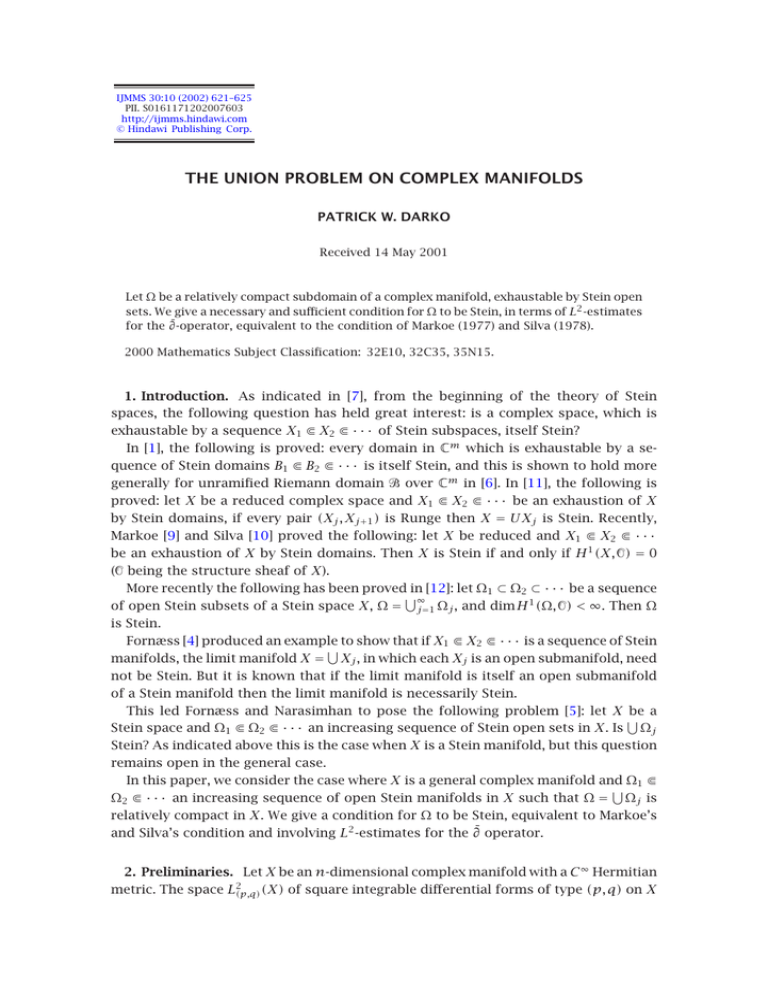
IJMMS 30:10 (2002) 621–625
PII. S0161171202007603
http://ijmms.hindawi.com
© Hindawi Publishing Corp.
THE UNION PROBLEM ON COMPLEX MANIFOLDS
PATRICK W. DARKO
Received 14 May 2001
Let Ω be a relatively compact subdomain of a complex manifold, exhaustable by Stein open
sets. We give a necessary and sufficient condition for Ω to be Stein, in terms of L2 -estimates
¯
for the ∂-operator,
equivalent to the condition of Markoe (1977) and Silva (1978).
2000 Mathematics Subject Classification: 32E10, 32C35, 35N15.
1. Introduction. As indicated in [7], from the beginning of the theory of Stein
spaces, the following question has held great interest: is a complex space, which is
exhaustable by a sequence X1 X2 · · · of Stein subspaces, itself Stein?
In [1], the following is proved: every domain in Cm which is exhaustable by a sequence of Stein domains B1 B2 · · · is itself Stein, and this is shown to hold more
generally for unramified Riemann domain Ꮾ over Cm in [6]. In [11], the following is
proved: let X be a reduced complex space and X1 X2 · · · be an exhaustion of X
by Stein domains, if every pair (Xj , Xj+1 ) is Runge then X = UXj is Stein. Recently,
Markoe [9] and Silva [10] proved the following: let X be reduced and X1 X2 · · ·
be an exhaustion of X by Stein domains. Then X is Stein if and only if H 1 (X, ᏻ) = 0
(ᏻ being the structure sheaf of X).
More recently the following has been proved in [12]: let Ω1 ⊂ Ω2 ⊂ · · · be a sequence
∞
of open Stein subsets of a Stein space X, Ω = j=1 Ωj , and dim H 1 (Ω, ᏻ) < ∞. Then Ω
is Stein.
Fornæss [4] produced an example to show that if X1 X2 · · · is a sequence of Stein
manifolds, the limit manifold X = Xj , in which each Xj is an open submanifold, need
not be Stein. But it is known that if the limit manifold is itself an open submanifold
of a Stein manifold then the limit manifold is necessarily Stein.
This led Fornæss and Narasimhan to pose the following problem [5]: let X be a
Stein space and Ω1 Ω2 · · · an increasing sequence of Stein open sets in X. Is Ωj
Stein? As indicated above this is the case when X is a Stein manifold, but this question
remains open in the general case.
In this paper, we consider the case where X is a general complex manifold and Ω1 Ω2 · · · an increasing sequence of open Stein manifolds in X such that Ω = Ωj is
relatively compact in X. We give a condition for Ω to be Stein, equivalent to Markoe’s
and Silva’s condition and involving L2 -estimates for the ∂¯ operator.
2. Preliminaries. Let X be an n-dimensional complex manifold with a C ∞ Hermitian
metric. The space L2(p,q) (X) of square integrable differential forms of type (p, q) on X
622
PATRICK W. DARKO
is a Hilbert space under the scalar product,
(f , g) =
X
f∧ ∗ ḡ,
(2.1)
where ∗ is the Hodge ∗-operator associated with the metric and orientation of X.
Let Ω1 Ω2 · · · be an increasing sequence of Stein open sets in X such that their
∞
union Ω = j=1 Ωj is relatively compact in X.
The following theorem is our main result.
Theorem 2.1. The union Ω is Stein if and only if given an f ∈ L2(p,q) (Ω), which is
¯
¯ = f in the
∂-closed in the sense of distributions, there is a u ∈ L2(p,q−1) (Ω) such that ∂u
sense of distributions and
uL2
(p,q−1)(Ω)
≤ Kf L2
(p,q)(Ω)
,
q > 0,
(2.2)
where K depends on Ω.
Let U be a bounded open set in Cn , and ᏻ the structure sheaf of Cn . A section
f = (f1 , . . . , fp ) ∈ Γ (U , ᏻp ), where p > 0 is an integer, is L2 -bounded if
f L2 (U ) = f1 L2 (U ) + · · · + bfp L2 (U ) < ∞.
(2.3)
We then denote all sections of ᏻp over U that are L2 -bounded by Γ2 (U, ᏻp ).
For the definition of L2 -bounded sections of coherent analytic sheaves, we require
the coherent analytic sheaf Ᏺ to be defined on a simply connected polycylinder neighborhood V of the closure of U. Then by [8, Theorem 5, Section F, Chapter VI], there is
an ᏻ-homographic in another simply connected polycylinder neighborhood V of the
closure of U ,
λ
ᏻp →
Ᏺ → 0,
(2.4)
where p > 0 is some integer; and f ∈ Γ (U , Ᏺ) is L2 -bounded if f ∈ Γ2 (U, Ᏺ) := λ(Γ2 (U,
ᏻp )). It can be shown that Γ2 (U , Ᏺ) is independent of λ and p, so that Γ2 (U, Ᏺ) is well
defined.
Now let Ω be a relatively compact subdomain of an n-dimensional complex manifold
X. An open subset Y of Ω is said to be admissible for the coherent analytic sheaf Ᏺ
defined in the neighborhood of the closure of Ω in X, if Y is Stein. There is a coordinate
neighborhood V in X of the closure, Ȳ of Y such that V is biholomorphic to a simply
connected polycylinder V in Cn , and Ȳ is contained in the neighborhood of Ω̄ where
Ᏺ is defined as f ∈ Γ (Y , Ᏺ) which is L2 -bounded if
f ∈ Γ2 (Y , Ᏺ) := g ∈ Γ (Y , Ᏺ) : η∗ (g) ∈ Γ2 η(Y ), η∗ (Ᏺ) ,
(2.5)
where η is the restriction of the biholomorphic map V → V 1 to Y , and η∗ (Ᏺ) is the
zero direct image of Ᏺ on Y .
Let Ω be as in Theorem 2.1 (then clearly Ω is locally Stein). Let Ᏺ be a coherent
analytic sheaf in a neighborhood of the closure of Ω. Then it is clear that Ω is a finite
m
union, Ω = j=1 Uj , where each Uj is admissible for Ᏺ. If ᐂ = {Uj }j∈I , I = {1, . . . , m},
623
THE UNION PROBLEM ON COMPLEX MANIFOLDS
where the Uj ’s are as above, we say that ᐂ is a finite admissible cover of Ω for Ᏺ and
we define the L2 (alternate) q-cochains of ᐂ with values in Ᏺ as those cochains,
c = cα ∈ C q (ᐂ, Ᏺ) =
Γ Uα , Ᏺ ,
α∈I q+1
Uα = Ui0 ∩ · · · ∩ Uiq ,
(2.6)
α = i0 , . . . , iq ,
q
which are alternate and satisfy cα ∈ Γ2 (Uα , Ᏺ) for all α ∈ I q+1 . We denote by C2 (ᐂ, Ᏺ)
the space of L2 -bounded cochains.
The coboundary operator,
δ : C q (ᐂ, Ᏺ) → C q+1 (ᐂ, Ᏺ),
q
q+1
q
(2.7)
q
q
maps C2 (ᐂ, Ᏺ) into C2 (ᐂ, Ᏺ). If Z2 (ᐂ, Ᏺ) = {c ∈ C2 (ᐂ, Ᏺ) : δc = 0} and B2 (ᐂ, Ᏺ) =
q−1
q
q
q
q
δC2 (ᐂ, Ᏺ), then as usual B2 (ᐂ, Ᏺ) ⊆ Z2 (ᐂ, Ᏺ) and we define H2 (ᐂ, Ᏺ) := Z2 (ᐂ, Ᏺ)/
q
B2 (ᐂ, Ᏺ) and call it the L2 -bounded cohomology of ᐂ with values in Ᏺ. We then have
the following theorem.
Theorem 2.2. For any q > 0, the natural map
q
H2 (ᐂ, Ᏺ) → H q (Ω, Ᏺ)
(2.8)
is an isomorphism.
We use Theorem 2.2 as a pivot to prove Theorem 2.1, but the proof of Theorem 2.2
is not given here, since it is similar to that of [2, Theorem].
3. A triangle of isomorphisms. Let Ω be as in Theorem 2.1. By the end of the secp
tion Theorem 2.1 will be proved. If U ≠ ∅ is an open set in Ω̄, then ᏮΩ (U) is the
Hilbert space of holomorphic p-forms h on Ω ∩ U such that
hL2
(p,0)(Ω∩U )
< ∞.
(3.1)
p
p
If V is open in Ω̄ with ∅ ≠ V ⊂ U, the restriction map γVU : ᏮΩ (U) → ᏮΩ (V ) is defined.
p
p
Then Ꮾ0 = {ᏮΩ (U ), γVU } is the canonical presheaf of L2 -holomorphic p-forms on Ω̄.
p
The associated sheaf Ꮾ2 is the sheaf of germs of L2 -holomorphic p-forms on Ω̄. We
then have the following lemma.
Lemma 3.1. Let Ᏸp be the sheaf of germs of holomorphic p-forms on X, and ᐂ a
finite admissible cover of Ω for Ᏸp . Then the following diagram is an isomorphism
triangle of cohomology groups:
q
H2 ᐂ, Ᏸp
∼
p
H q Ω̄, Ꮾ2
for q ≥ 1 and p ≥ 0.
H q Ω, Ᏸp
(3.2)
624
PATRICK W. DARKO
Proof. From Theorem 2.2 and the fact that any finite cover of Ω̄ has a refinement
ᐁ = {Vj }j∈J such that ᐁΩ = {Vj ∩ Ω}j∈J is a finite admissible cover of Ω for Ᏸp , the
lemma follows.
Now, using Hörmander’s L2 -estimates locally we get the following lemma.
p
Lemma 3.2. The cohomology group H q (Ω̄, Ꮾ2 ) is isomorphic to the quotient space
2
¯ = 0 / ∂h
¯ : h ∈ L2
¯
g : g ∈ L2(p,q) (Ω) and ∂g
p,q−1 (Ω) and ∂h ∈ L(p,q) (Ω) ,
(3.3)
where Ω is as in Theorem 2.1.
Also the following lemma is proved in [3].
Lemma 3.3. If Ω X is Stein, where X is a complex manifold, then given f ∈
¯ = 0, there is u ∈ L2
with ∂f
(p,q−1) (Ω) such that
L2(p,q) (Ω)
¯ = f,
∂u
uL2
(p,q−1)(Ω)
≤ Kf L2 (p,q)(Ω) ,
(3.4)
where K depends on Ω.
To finish with the proof of Theorem 2.1 we remark that Ᏸ0 = ᏻ is the structure
sheaf of X (X, Ω as in Theorem 2.1), therefore Theorem 2.1 follows from Lemmas 3.1,
3.2, and 3.3, and from Markoe’s and Silva’s condition.
References
[1]
[2]
[3]
[4]
[5]
[6]
[7]
[8]
[9]
[10]
[11]
H. Behnke and K. Stein, Konvergente folge von regularit ätsbereichen und die meromorphiekonvexität, Math. Ann. 116 (1938), 204–216 (German).
P. W. Darko, On cohomology with bounds on complex spaces, Atti Accad. Naz. Lincei Rend.
Cl. Sci. Fis. Mat. Natur. (8) 60 (1976), no. 3, 189–194.
, L2 estimates for the ∂ operator on Stein manifolds, Math. Proc. Cambridge Philos.
Soc. 129 (2000), no. 1, 73–76.
J. E. Fornæss, An increasing sequence of Stein manifolds whose limit is not Stein, Math.
Ann. 223 (1976), no. 3, 275–277.
J. E. Fornæss and R. Narasimhan, The Levi problem on complex spaces with singularities,
Math. Ann. 248 (1980), no. 1, 47–72.
H. Grauert and R. Remmert, Konvexität in der komplexen Analysis. Nicht-holomorphkonvexe Holomorphiegebiete und Anwendungen auf die Abbildungstheorie, Comment. Math. Helv. 31 (1956), 152–160, 161–183 (German).
, Theory of Stein Spaces, Springer-Verlag, Berlin, 1979.
R. C. Gunning and H. Rossi, Analytic Functions of Several Complex Variables, PrenticeHall, New Jersey, 1965.
A. Markoe, Runge families and inductive limits of Stein spaces, Ann. Inst. Fourier (Grenoble) 27 (1977), no. 3, 117–127.
A. Silva, Rungescher Satz and a condition for Steinness for the limit of an increasing
sequence of Stein spaces, Ann. Inst. Fourier (Grenoble) 28 (1978), no. 2, 187–200
(German).
K. Stein, Überlagerungen holomorph-vollständiger komplexer Räume, Arch. Math. 7
(1956), 354–361 (German).
THE UNION PROBLEM ON COMPLEX MANIFOLDS
[12]
625
L. M. Tovar, Open Stein subsets and domains of holomorphy in complex spaces, Topics in
Several Complex Variables (Mexico, 1983), Pitman, Massachusetts, 1985, pp. 183–
189.
Patrick W. Darko: Department of Mathematics and Computer Science, Lincoln University, Lincoln University, PA 19352, USA
E-mail address: pdarko@lu.lincoln.edu
